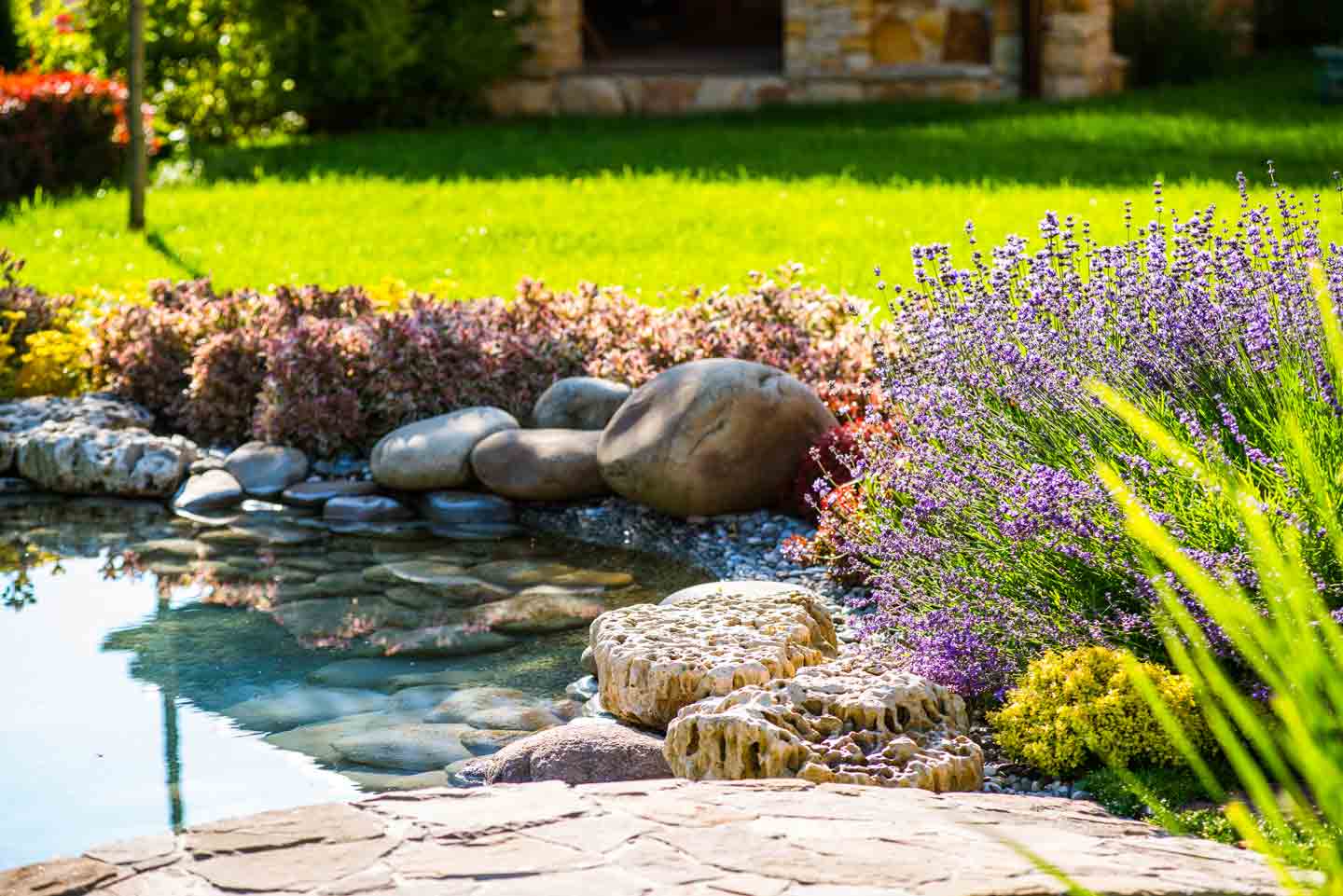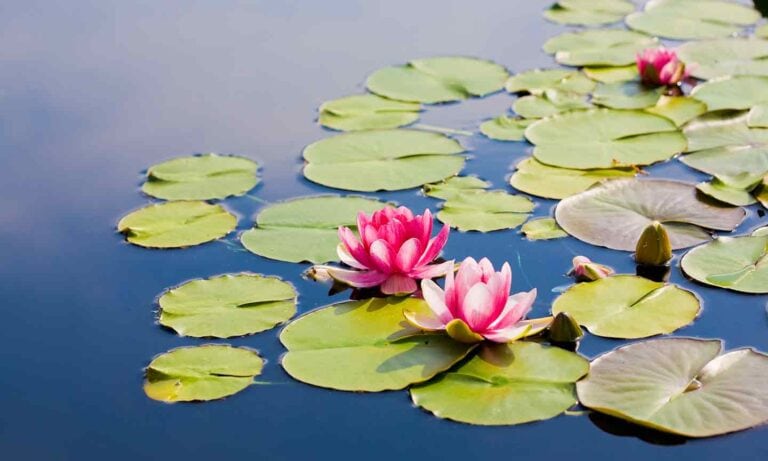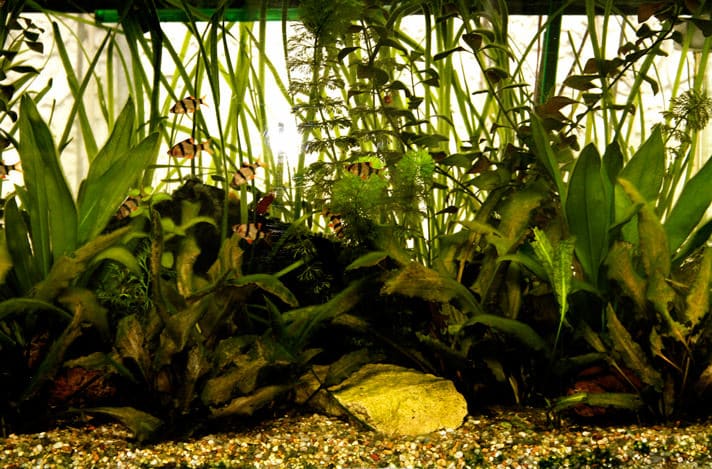In This Guide:
Importance of Pond Filtration
Filtration is the key to maintaining a healthy pond ecosystem. On the surface, a pond filter system removes physical debris like fish waste and decomposing plant matter to keep the water clear. By removing organic matter before it can break down, pond filters also help keep ammonia levels in check—a function that is particularly important in ponds stocked with fish.
Ammonia is a byproduct of decomposition and, in concentrations over 0.05 mg/L, can be harmful to fish. According to the Merck Veterinary Manual, ammonia concentrations of 2 mg/L can even be lethal for many fish.
On a microscopic level, certain types of filters for a pond promote the growth of beneficial bacteria that help remove excess nutrients and other unwanted particles from the water. Pond filters also provide aeration, which helps improve the level of dissolved oxygen in the water.
Types of Pond Filters
Whether it’s a small backyard pond or an elaborate build, filtering a pond is non-negotiable if you want it to look attractive and support life. Here’s what you need to know about the different types of filters for a pond.
Biological Filtration
Jessie Sanders, DVM, DABVP (Fish Practice), owner and chief veterinarian of Aquatic Veterinary Services in Santa Cruz County, California, suggests biological filtration is the most important type of fish pond filter.
“Biological filtration is essential for ponds,” she says, “because it houses beneficial bacteria that drive the pond’s nitrogen cycle.”
A biological pond filtration system utilizes a submersible pump to draw oxygen-rich water through the filter housing. The housing is filled with porous or textured filter media like foam, ceramic rings, or bio balls that provide surface area on which beneficial bacteria can grow.
Those bacteria facilitate the process of converting ammonia (NH3) into nitrite (NO2) and then nitrate (NO3). Nitrate is less harmful for fish, and can be removed from the system via water changes or absorption by aquatic plants.
In short, biological filters help maintain the natural balance of aquatic ecosystems. In addition to removing harmful substances from the water, these filters improve water quality and clarity so your pond will look its best.
Biological filters for ponds can be as basic as a plastic tub filled with porous media connected to a pump that pulls pond water through the media. A classic example is the waterfall filter, in which a pump pulls water up into the tub and it returns to the pond via a waterfall or spillway. An external canister filter provides biological filtration by pumping water out of the pond, through the filter media, and back into the pond via waterfall or stream.
Mechanical Filtration
According to Tim Wood, an Aquascape®-certified contractor and founder of Aquatic Edge Pond & Landscape Solutions in Pittsburgh, “Mechanical filtration means the physical removal of debris from the water, such as leaves and grass clippings.”
Removing physical debris helps keep your pond clean and clear; it also slows the rate of ammonia accumulation.
While biological filtration of some kind is recommended for all ponds, installing a separate mechanical filter may not be necessary if you’re willing to do the work manually. Surface debris can be removed using a pond net, and you can also hang netting over the pond to catch leaves and other fallen debris. If you go this route, however, you may need to deep-clean the pond occasionally to remove accumulated waste from the bottom.
If you prefer to automate the process, Wood notes that many filtration systems provide both mechanical and biological filtration. In a waterfall filter, for example, water typically passes through a dense fiber mat to catch particles before it reaches the biological filter bed. Pressurized pond filters often use foam pads to absorb large particles.
A pond skimmer is an example of a standalone mechanical filter that collects debris from the surface of the water.
A submersible filter box is another option—it may provide adequate mechanical filtration in a small pond or, provide supplemental filtration in a large pond.
Sterilizers
A pond sterilizer shouldn’t be a replacement for biological or mechanical filtration, but it can be a beneficial add-on. Pond sterilizers and UV clarifiers use ultraviolet light to kill algae, parasites, and other harmful pathogens in the water.
Not all ponds will require a sterilizer, but Wood says such devices “can be useful in clearing green water in ponds that tend to suffer from the issue.” It’s worth noting, however, that UV clarifiers are only effective against single-celled floating algae. Pond water has to pass through the sterilizer or clarifier to be treated, so algae attached to rocks or other surfaces won’t be affected.
A UV sterilizer or clarifier can be added to an existing pond filtration system, or hooked up to a separate pump and fountain. Some pressurized pond filters also provide UV sterilization.
Natural Pond Filtration Methods

As an alternative to installing pond filtration equipment, you may be able to establish a DIY pond filter system using a combination of plants, beneficial bacteria media, and pumps.
Using Plants for Natural Filtration
Aquatic plants support natural filtration in several ways. “Plant roots uptake nutrients and even some pollutants,” Wood says. The roots and any substrate they’re planted in may also provide surfaces on which beneficial bacteria can grow.
It’s best to choose native plants that are adapted to local conditions and include a variety to promote biodiversity. The more plants you have, the less likely algae is to be a problem—the plants will compete with algae for nutrients. Keep in mind that sunlight will contribute to algae growth as well, so make sure your pond is shaded for part of the day.
To promote healthy plant life, you may want to install aeration equipment to boost circulation and dissolved oxygen levels. You may also need to add aquatic plant fertilizer from time to time.
Bog Garden Filtration Technique
While aquatic plants may be adequate filters for small ponds, large ponds may require a more complex natural filtration system. A bog filter uses a combination of gravel and aquatic plants to support biological filtration.
Creating a bog filter involves building a pond next to or around your main pond. It should be about 10%–20% the size of your main pond, and connected via submersible pumps and tubing. One pump will run water from the main pond into the bog pond and another will return bog-filtered water to the pond.
The bog pond should be lined with gravel to collect organic debris and serve as a breeding ground for beneficial bacteria. As the debris breaks down, it provides nutrients for bog plants that provide additional biological filtration.
Choosing the Right Filtration System for Your Pond
When it comes to filtering a pond, there are many ways to accomplish the same goal. The method you choose may depend on the size of your pond, your budget, and how much effort you’re willing to put into maintenance.
Wood divides pond filtration systems into two categories: European and ecosystem. The European style, he says, “utilizes extensive plumbing and external filters, which require frequent backflushing and routine maintenance.” Ecosystem or natural filters, Wood says, “typically require less routine maintenance … but you will need to have an annual or biannual deep cleaning of the pond to remove some accumulated debris from the gravel bed.”
Any pond filtration system can become expensive, but natural filters tend to be more economical. If you don’t have budgetary concerns, your choice may come down to maintenance requirements and the overall look you want to create with your pond.
Filtering a Pond FAQs
Q:What is the best way to filter pond water?
A:The best pond filter system provides both mechanical filtration and biological filtration. Mechanical filtration removes physical debris, while biological filtration utilizes a combination of aquatic plants and beneficial bacteria to absorb excess nutrients and pollutants.
Q:Should you filter a pond?
A:Yes. “Without adequate filtration,” says Wood, “your pond will turn green and won’t be able to support as many fish, if any at all.”
Q:How do you naturally filter a small pond?
A:In a small pond, floating aquatic plants may provide adequate biological filtration. You may still need to manually remove surface debris and clean the pond seasonally to remove excess algae and accumulated waste.
Q:Can you filter pond water for drinking?
A:Yes, filtered pond water can be made safe to drink. On top of running a regular pond filtration system, however, the water will need to be treated and purified to remove contaminants and pathogens.
Share:













